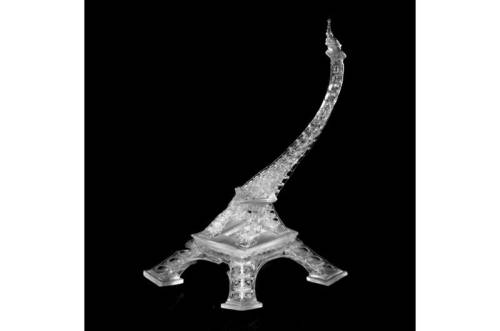#cross linking
Dynamic 3-D printing process features a light-driven twist
The speed of light has come to 3-D printing. Northwestern University engineers have developed a new method that uses light to improve 3-D printing speed and precision while also, in combination with a high-precision robot arm, providing the freedom to move, rotate or dilate each layer as the structure is being built.
Most conventional 3-D printing processes rely on replicating a digital design model that is sliced into layers with the layers printed and assembled upwards like a cake. The Northwestern method introduces the ability to manipulate the original design layer by layer and pivot the printing direction without recreating the model. This “on-the-fly” feature enables the printing of more complicated structures and significantly improves manufacturing flexibility.
“The 3-D printing process is no longer a way to merely make a replica of the designed model,” said Cheng Sun, associate professor of mechanical engineering at Northwestern’s McCormick School of Engineering. “Now we have a dynamic process that uses light to assemble all the layers but with a high degree of freedom to move each layer along the way.”
Post link
Macromolecular order in plastic kingdom
A team of researchers at the Institute of Synthetic Polymer Materials of the Russian Academy of Sciences, MIPT and elsewhere has determined how the regularity of polypropylene molecules and thermal treatment affect the mechanical properties of the end product. Their new insights make it possible to synthesize a material with predetermined properties such as elasticity or hardness. The paper detailing the study was published in Polymer.
In terms of production volume, polypropylene it is second only to polyethylene. By tweaking its molecular structure, polypropylene can be used to manufacture materials with a wide range of features, from elastic bands to high-impact plastic. However, the relationship between the polymer’s chemical structure and its mechanical properties is not fully understood.
What makes the properties of polymer materials so variable is their makeup. A polymer molecule is a long chain of repeating units of unequal length. If these molecules are jumbled up more or less at random in a material, it is said to be amorphous. Such polymers are soft. In other materials, the polymer chains form interconnections called crosslinks. This gives rise to regions of highly regular atomic structure (fig. 1), similar to that of crystals, hence the name crystallites. They hold the whole molecular network together, and the more crystallites there are in a material, the harder it is. To form crosslinks, molecular chains need to possess a certain structural regularity called isotacticity.
Post link
Process improves strength, color of feather-based fibers
Domesticated chickens in the United States alone produce more than 2 billion pounds of feathers annually. Those feathers have long been considered a waste product, especially when contaminated with blood, feces or bacteria that can prove hazardous to the environment.
Nebraska’s Yiqi Yang is among a growing cadre of researchers looking to transform those feathers into fibers that find a place in natural fabrics. In that vein, Yang and his Husker colleagues are devising and testing methods to improve the properties of feather-derived fibers.
Those methods include cross-linking: chemically bonding long protein chains—including keratin, a water-resistant protein of feathers—to bolster the performance of the resulting fibers and fabrics. But that performance must still improve, and unwanted side effects of cross-linking be resolved, before feathers emerge as a greener alternative to petroleum-based materials—polyester, nylon—currently dominating the market.
Post link



